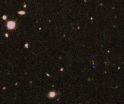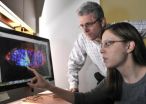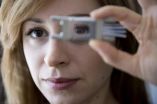(Press-News.org) VIDEO:
This is an interview with Professor Artur Ekert, co-inventor of quantum cryptography, about what it takes to keep secrets secret.
Click here for more information.
Revelations of the extent of government surveillance have thrown a spotlight on the security – or lack thereof – of our digital communications. Even today's encrypted data is vulnerable to technological progress. What privacy is ultimately possible? In the 27 March issue of Nature, the weekly international journal of science, researchers Artur Ekert and Renato Renner review what physics tells us about keeping our secrets secret.
In the history of secret communication, the most brilliant efforts of code-makers have been matched time and again by the ingenuity of code-breakers. Sometimes we can even see it coming. We already know that one of today's most widely used encryption systems, RSA, will become insecure once a quantum computer is built.
But that story need not go on forever. "Recent developments in quantum cryptography show that privacy is possible under stunningly weak assumptions about the freedom of action we have and the trustworthiness of the devices we use," says Ekert, Professor of Quantum Physics at the University of Oxford, UK, and Director of the Centre for Quantum Technologies at the National University of Singapore. He is also the Lee Kong Chian Centennial Professor at the National University of Singapore.
Over 20 years ago, Ekert and others independently proposed a way to use the quantum properties of particles of light to share a secret key for secure communication. The key is a random sequence of 1s and 0s, derived by making random choices about how to measure the particles (and some other steps), that is used to encrypt the message. In the Nature Perspective, he and Renner describe how quantum cryptography has since progressed to commercial prospect and into new theoretical territory.
Even though privacy is about randomness and trust, the most surprising recent finding is that we can communicate secretly even if we have very little trust in our cryptographic devices – imagine that you buy them from your enemy – and in our own abilities to make free choices – imagine that your enemy is also manipulating you. Given access to certain types of correlations, be they of quantum origin or otherwise, and having a little bit of free will, we can protect ourselves. What's more, we can even protect ourselves against adversaries with superior technology that is unknown to us.
"As long as some of our choices are not completely predictable and therefore beyond the powers that be, we can keep our secrets secret," says Renner, Professor of Theoretical Physics at ETH Zurich, Switzerland. This arises from a mathematical discovery by Renner and his collaborator about 'randomness amplification': they found that a quantum trick can turn some types of slightly-random numbers into completely random numbers. Applied in cryptography, such methods can reinstate our abilities to make perfectly random choices and guarantee security even if we are partially manipulated.
"As well as there being exciting scientific developments in the past few years, the topic of cryptography has very much come out of the shadows. It's not just spooks talking about this stuff now," says Ekert, who has worked with and advised several companies and government agencies.
The semi-popular essay cites 68 works, from the writings of Edgar Allen Poe on cryptography in 1841, through the founding papers of quantum cryptography in 1984 and 1991, right up to a slew of results from 2013.
The authors conclude that "The days we stop worrying about untrustworthy or incompetent providers of cryptographic services may not be that far away".
INFORMATION:
Reference
A. Ekert and R. Renner "The ultimate physical limits of privacy", Nature doi:10.1038/nature13132 (2014)
After publication, the paper will be available at http://dx.doi.org/10.1038/nature13132
Researcher contacts
Artur Ekert
Professor of Quantum Physics at the Mathematical Institute, University of Oxford
Director, Centre for Quantum Technologies and Lee Kong Chian Centennial Professor at the National University of Singapore
Email: artur.ekert@qubit.org
[Ekert is currently in Singapore]
Renato Renner
Professor of Theoretical Physics, ETH Zurich, Switzerland
Tel: +41 44 633 34 58
E-Mail: renner@phys.ethz.ch
Keeping secrets in a world of spies and mistrust
2014-03-26
ELSE PRESS RELEASES FROM THIS DATE:
Cell-saving drugs could reduce brain damage after stroke
2014-03-26
Long-term brain damage caused by stroke could be reduced by saving cells called pericytes that control blood flow in capillaries, reports a new study led by scientists from UCL (University College London).
Until now, many scientists believed that blood flow within the brain was solely controlled by changes in the diameter of arterioles, blood vessels that branch out from arteries into smaller capillaries. The latest research reveals that the brain's blood supply is in fact chiefly controlled by the narrowing or widening of capillaries as pericytes tighten or loosen around ...
Should whole-genome sequencing become part of newborn screening?
2014-03-26
That question is likely to stir debate in coming years in many of the more-than-60 countries that provide newborn screening, as whole-genome sequencing (WGS) becomes increasingly affordable and reliable. Newborn screening programs – which involve drawing a few drops of blood from a newborn's heel – have been in place since the late 1960s, and are credited with having saved thousands of lives by identifying certain genetic, endocrine or metabolic disorders that can be treated effectively when caught early enough. Advocates of routine WGS for newborns argue that the new technology ...
Solar System's edge redefined
2014-03-26
Washington, D.C.—The Solar System has a new most-distant member, bringing its outer frontier into focus.
New work from Carnegie's Scott Sheppard and Chadwick Trujillo of the Gemini Observatory reports the discovery of a distant dwarf planet, called 2012 VP113, which was found beyond the known edge of the Solar System. This is likely one of thousands of distant objects that are thought to form the so-called inner Oort cloud. What's more, their work indicates the potential presence of an enormous planet, perhaps up to 10 times the size of Earth, not yet seen, but possibly ...
Penn Dental Medicine-NIH team reverses bone loss in immune disorder
2014-03-26
Patients with leukocyte adhesion deficiency, or LAD, suffer from frequent bacterial infections, including the severe gum disease known as periodontitis. These patients often lose their teeth early in life.
New research by University of Pennsylvania School of Dental Medicine researchers, teaming with investigators from the National Institutes of Health, has demonstrated a method of reversing this bone loss and inflammation.
The work was led by Penn Dental Medicine's George Hajishengallis, professor in the Department of Microbiology, in collaboration with Niki Moutsopoulos ...
Researchers present comprehensive 'roadmap' of blood cells
2014-03-26
(WASHINGTON, March 26, 2014) – Research published online today in Blood, the Journal of the American Society of Hematology, presents an unprecedented look at five unique blood cells in the human body, pinpointing the location of key genetic regulators in these cells and providing a new tool that may help scientists to identify how blood cells form and shed light on the etiology of blood diseases.
Work published today in Blood* is a subset of a much larger catalog of genetic information about nearly 1,000 human cells and tissues unveiled today from the international research ...
3-D MRI scans may offer better way to predict survival after chemo for liver tumors
2014-03-26
In a series of studies involving 140 American men and women with liver tumors, researchers at Johns Hopkins have used specialized 3-D MRI scans to precisely measure living and dying tumor tissue to quickly show whether highly toxic chemotherapy – delivered directly through a tumor's blood supply – is working.
The investigators say their findings, to be presented March 22-27 in San Diego at the annual meeting of the Society of Interventional Radiology, are the first "proof of principle" that this technology can show tumors in three dimensions and accurately measure tumor ...
Lawrence Livermore scientists discover bacterial resistance to improve biofuel production
2014-03-26
Resistance is not futile when it comes to a new method to more efficiently convert biomass to biofuels.
New research by scientists from Lawrence Livermore National Laboratory in conjunction with the Joint BioEnergy Institute (JBEI) suggests that a type of bacterial resistance may provide more efficient production of biofuels.
The team identified the genetic origin of bacterial resistance to an ionic liquid (a salt in the liquid state), which they successfully introduced into a strain of E. coli bacteria for the production of advanced biofuels. The ionic liquid resistance ...
Significant progress toward creating 'benchtop human' reported
2014-03-26
Significant progress toward creating "homo minutus" - a benchtop human -was reported at the Society of Toxicology meeting on Mar. 26 in Phoenix.
The advance - successful development and analysis of a liver human organ construct that responds to exposure to a toxic chemical much like a real liver- was described in a presentation by John Wikswo, the Gordon A. Cain University Professor and Director of the Vanderbilt Institute for Integrative Biosystems Research and Education (VIIBRE) at Vanderbilt University.
The achievement is the first result from a five-year, $19 million ...
UT Southwestern cancer biologists link tumor suppressor gene to stem cells
2014-03-26
DALLAS – March 26, 2014 – Just as archeologists try to decipher ancient tablets to discern their meaning, UT Southwestern Medical Center cancer biologists are working to decode the purpose of an ancient gene considered one of the most important in cancer research.
The p53 gene appears to be involved in signaling other cells instrumental in stopping tumor development. But the p53 gene predates cancer, so scientists are uncertain what its original function is.
In trying to unravel the mystery, Dr. John Abrams, Professor of Cell Biology at UT Southwestern, and his team ...
Biological testing tool, ScanDrop, tests in fraction of time and cost of industry standard
2014-03-26
Northeastern University professor of pharmaceutical sciences, Tania Konry, has developed a single instrument that can conduct a wide range of biological scans in a fraction of the time and cost of industry standard equipment. That's because it uses considerably less material and ultra-sensitive detection methods to do the same thing.
Currently, researchers face enormous time constraints and financial hurdles from having to run these analyses on a regular basis. Hundreds of dollars and 24 hours are what's required to scan biological materials for important biomarkers that ...





